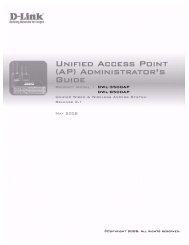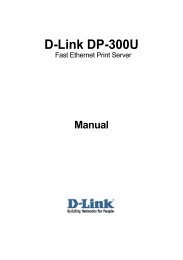Product Manual
Product Manual
Product Manual
You also want an ePaper? Increase the reach of your titles
YUMPU automatically turns print PDFs into web optimized ePapers that Google loves.
DES-3526 / DES-3526DC Fast Ethernet Layer 2 Switch<br />
D-Link Single IP Management<br />
Single IP Management (SIM) Overview<br />
Topology<br />
Firmware Upgrade<br />
Configuration Backup/Restore<br />
182<br />
Section 10<br />
Single IP Management (SIM) Overview<br />
Simply put, D-Link Single IP Management is a concept that will stack switches together over Ethernet<br />
instead of using stacking ports or modules. There are some advantages in implementing the "Single IP<br />
Management" feature:<br />
1. SIM can simplify management of small workgroups or wiring closets while scaling the<br />
network to handle increased bandwidth demand.<br />
2. SIM can reduce the number of IP address needed in your network.<br />
3. SIM can eliminate any specialized cables for stacking connectivity and remove the distance<br />
barriers that typically limit your topology options when using other stacking technology.<br />
Switches using D-Link Single IP Management (labeled here as SIM) must conform to the following<br />
rules:<br />
• SIM is an optional feature on the Switch and can easily be enabled or disabled through the Command Line<br />
Interface or Web Interface. SIM grouping has no effect on the normal operation of the Switch in the user's<br />
network.<br />
• There are three classifications for switches using SIM. The Commander Switch (CS), which is the master<br />
switch of the group, Member Switch (MS), which is a switch that is recognized by the CS a member of a SIM<br />
group, and a Candidate Switch (CaS), which is a Switch that has a physical link to the SIM group but has not<br />
been recognized by the CS as a member of the SIM group.<br />
• A SIM group can only have one Commander Switch (CS).<br />
• All switches in a particular SIM group must be in the same IP subnet (broadcast domain). Members of a SIM<br />
group cannot cross a router.<br />
• A SIM group accepts up to 32 switches (numbered 0-31), including the Commander Switch (numbered 0).<br />
There is no limit to the number of SIM groups in the same IP subnet (broadcast domain), however a<br />
single switch can only belong to one group.<br />
If multiple VLANs are configured, the SIM group will only utilize the default VLAN on any switch.<br />
SIM allows intermediate devices that do not support SIM. This enables the user to manage switches<br />
that are more than one hop away from the CS.<br />
The SIM group is a group of switches that are managed as a single entity. The DES-3526 may take on<br />
three different roles:<br />
1. Commander Switch (CS) - This is a switch that has been manually configured as the<br />
controlling device for a group, and takes on the following characteristics:<br />
• It has an IP Address.<br />
• It is not a command switch or member switch of another Single IP group.<br />
• It is connected to the member switches through its management VLAN.

















